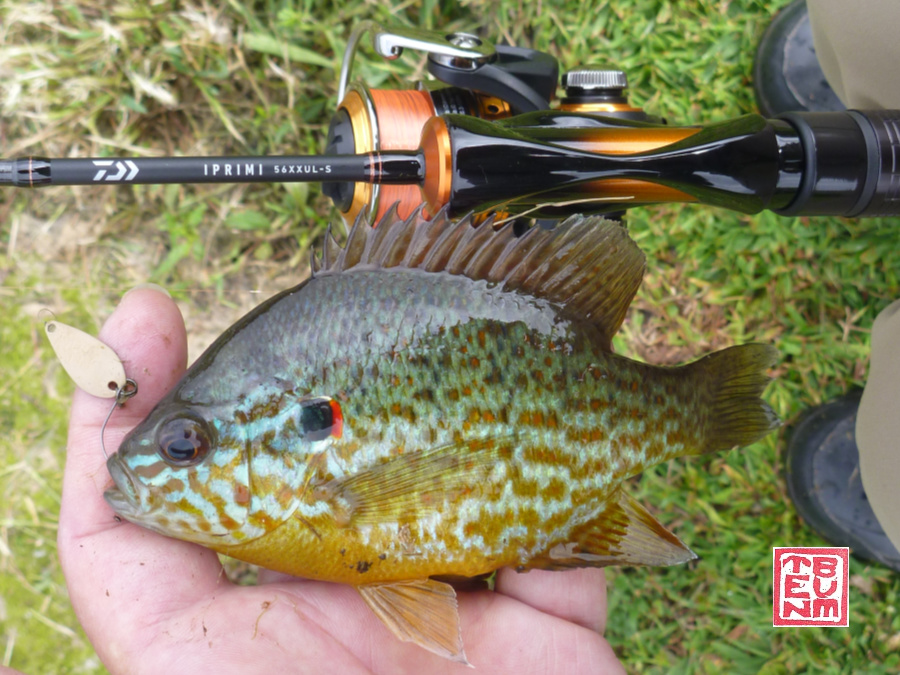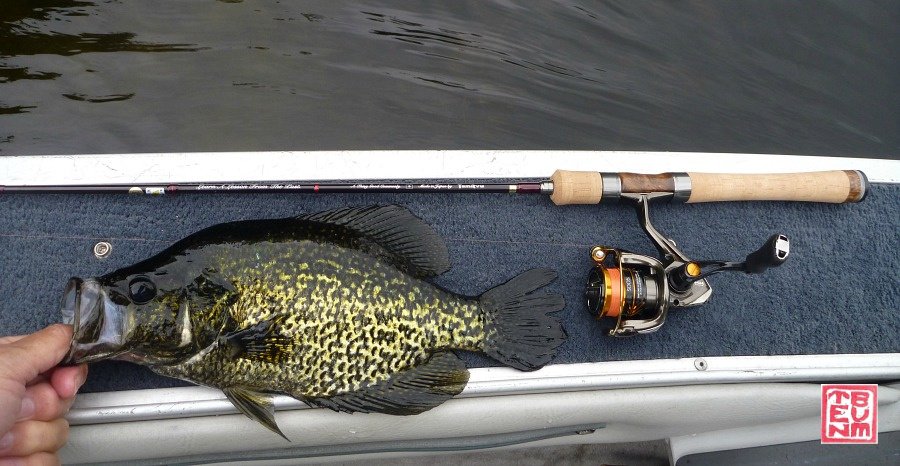Spoon Fishing for Panfish
Spoon Fishing for Panfish is much more effective than you might imagine. The key is to use a small spoon! They'll follow a larger spoon but will hit a small one with abandon!
The only reason more people don't use spoons to fish for panfish is because they don't know how well it works. The main reason they don't know how well it works is they've never had a spoon that was small enough.
Small spoons are available - if you know where to look.
(Hint: you're looking in the right place right now.)
Spoon Fishing for Panfish - The Spoons
 Micro spoons work very nicely for bluegills.
Micro spoons work very nicely for bluegills.Sunfish are opportunistic feeders. A sunfish will hit just about anything that will fit in its mouth. Jigs and small plastics work well if the fish are deep. Flies and poppers work well if the fish are near the surface - that is if you have a fly rod or tenkara rod.
But what if the fish are near the surface, or in shallow water, and you have an ultralight spinning rod? In that case, spoon fishing for panfish would be the ideal method. As explained on the Micro Spoons page, there is no industry standard definition of "micro spoon." Personally, I would consider a spoon of 1/16 oz (about 1.8 grams) or less to be a micro spoon. Spoons of that size are very rare in the US but are very popular in Japan.
 Color doesn't seem to be critical.
Color doesn't seem to be critical.In Japan, micro spoons are used almost exclusively for trout and almost exclusively in private pay-to-fish lakes called "Areas." Fishing for trout in the Areas is quite popular and there is a very wide selection of micro spoons. There are bluegills in Japan, but very few people fish for them.
 Pumpkinseed Sunfish, Daiwa Iprimi 56XXUL-S
Pumpkinseed Sunfish, Daiwa Iprimi 56XXUL-SThe first micro spoons I imported were Daiwa Presso Vega spoons in .8g and .4g weights. I imported them for trout. I hadn't even thought of spoon fishing for panfish - until I tried it. I was surprised how well it worked. The .4g were really a bit too light, even with rods rated for lures down to .4g, like the Daiwa Iprimi 56XXUL-S shown above. They could be cast far enough to catch fish but not as far as most people want to cast. Then again, most people might not realize you don't have to cast into the next county to catch fish.
 Daiwa Vega .8g spoon, Tenryu Rayz Alter RZA61L-T rod.
Daiwa Vega .8g spoon, Tenryu Rayz Alter RZA61L-T rod.On an August day a few years ago, I fished an office park pond with a rod designed for fishing micro spoons in Areas. The Tenryu Rayz Alter RZA61L-T was able to cast the .8 gram Vega spoons plenty far enough. It turned out to be a "many, many" day, with fish after fish after fish - mostly bluegills with a few largemouth bass and an occasional pumpkinseed. Sometimes they'd hit it as soon as it hit the water, as if it was a bug that fell out of a tree. Sometimes they'd hit it on the drop. Occasionally they'd slash at it from the side or from below. They wouldn't leave it alone!
As far as I can tell, if you are spoon fishing for panfish, there's only one way to do it wrong - and that is to fish too fast. If you fish a spoon slowly, it will wobble, which provides all the action that is required. When fishing for sunfish or crappies in a pond or lake, I have found it is not necessary to impart any additional action by either pulsing the rod or varying the retrieve. The slow wobble is all it takes. If you fish a spoon too fast they're likely to just watch it go by. They don't chase.
I would concentrate on the spoons that are no more than 1" long (Rodio-craft Blinde Flanker .5g, Forest Chaser .6g, Daiwa Eve 1g and 1.2g, Daiwa Micro Lumion .6g and 1.0g and Rodio-craft Cha2 Jr.)
Spoon Fishing for Panfish - The Rods
 Bluegill, Tenryu Rayz Integral RZI50UL-4
Bluegill, Tenryu Rayz Integral RZI50UL-4With respect to rods, just about any rod that will cast a lure of 1/16 oz or less will do, although if it will cast 1/32 oz (roughly 1 gram) that's even better. Unless you catch very large panfish (or end up catching unexpectedly large bass while fishing for panfish), an ultralight, super ultralight, extra ultralight, or extra extra ultralight would be ideal.
US rod manufacturers don't make the supers, extras, or extra extras, and their "ultralight" rods all seem to be rated for 6 lb test line. US 6 lb test line probably breaks at 8 lb or more - which is way, way to thick and stiff to fish micro spoons effectively. I generally fish with 2.5 or 3 lb line - and that's Japanese line that actually breaks at 2.5 or 3 lbs. If you must use US line, don't use anything stronger than 2 lb (which is really going to be 2.5 or 3 lb test).
I would highly recommend a Japanese rod when spoon fishing for panfish. A rod that is rated for line no stronger than 3 or 4 lb is going to be more fun than one rated for line that really breaks at 8 lb. US rods are overkill for panfish - even the ones that have "Panfish" written on 'em.
And if you decide to invest in an expensive JDM rod, trying to save a few bucks on a cheap US line is just silly. You will enjoy the experience a lot more with a good line. There really is a difference.
 Black Crappie, Tenryu Rayz Alter RZA61L-T
Black Crappie, Tenryu Rayz Alter RZA61L-TAlthough there are a lot of rods you could use when spoon fishing for panfish, I do think the best choice is a rod actually designed for fishing micro spoons - and that pretty much comes down to a rod designed for fishing in Areas. My favorite is the Tenryu Rayz Alter, either the tubular tipped RZA61L-T or the solid tipped RZA62UL-S. As with most Area rods, it is designed for light lures and light lines. It is relatively soft - in order to protect the light line - but it is definitely not a noodley, whippy rod. For that reason, although it is great for fishing small lures on light lines, it is not a good choice for Erne St Claire's wave casts.
 Redbreast Sunfish, Daiwa Area Bum 60L-B (since discontinued)
Redbreast Sunfish, Daiwa Area Bum 60L-B (since discontinued)Not many people use baitcasters to cast micro spoons, but a good BFS reel can easily cast 1.8 gram spoons. Unfortunately, there are very few baitcasters that are designed for fishing in Areas. The Daiwa Presso ST 60L-B and the Shimano Cardiff AX B62SUL-RG are two rods that would do nicely when spoon fishing for panfish. Although I have caught fish casting a 1 gram spoon with a baitcaster, I would recommend fishing the 1.6 or 1.8 gram spoons instead. They're heavy enough to cast with a BFS reel and a rod designed for fishing in Areas, and they're still small enough for panfish.
On a recent trip (for trout rather than panfish), I was pleasantly surprised at the ability of the Shimano Calcutta Conquest BFS HG and the Tenryu Rayz RZ4102B-UL (stream rod) to cast the Daiwa Presso Eve 1.2 gram spoons. The Eve spoons are essentially the same size as the 1.8 gram Forest Factor spoons (3/8" x 15/16"), which would be even easier to cast.
Take a look at the micro spoons. They work!
Finesse-Fishing Home > Single Hook Lures > Spoon Fishing for Panfish
Header photo: Tenryu Rayz RZ4102B-UL, Shimano Calcutta Conquest BFSHG ('17)
Warning:
The hooks are sharp.
The coffee's hot.
The fish are slippery when wet.